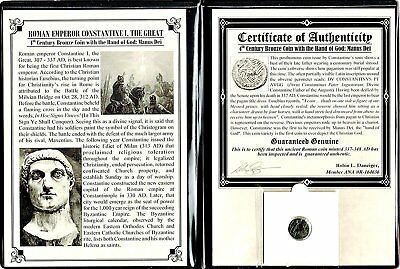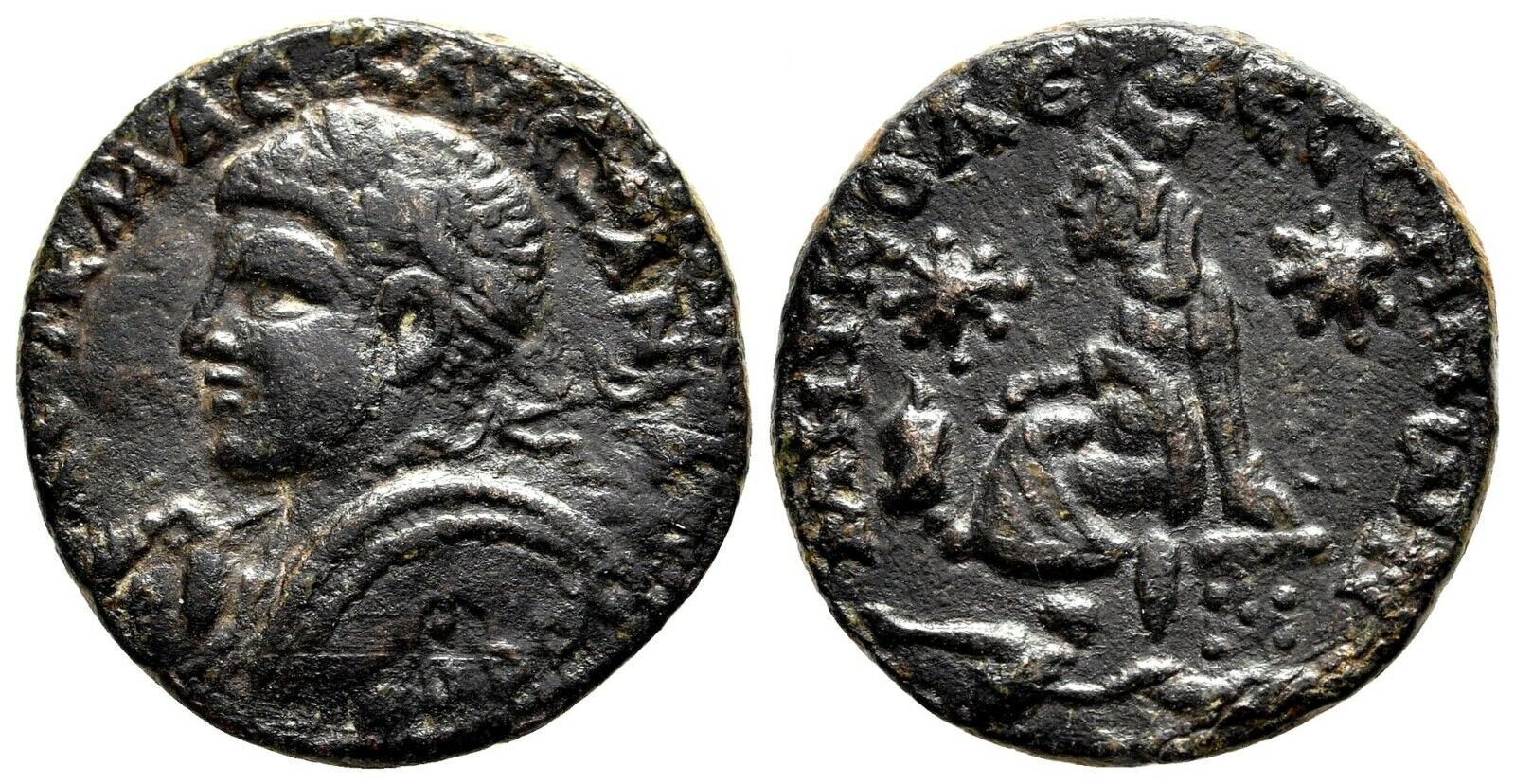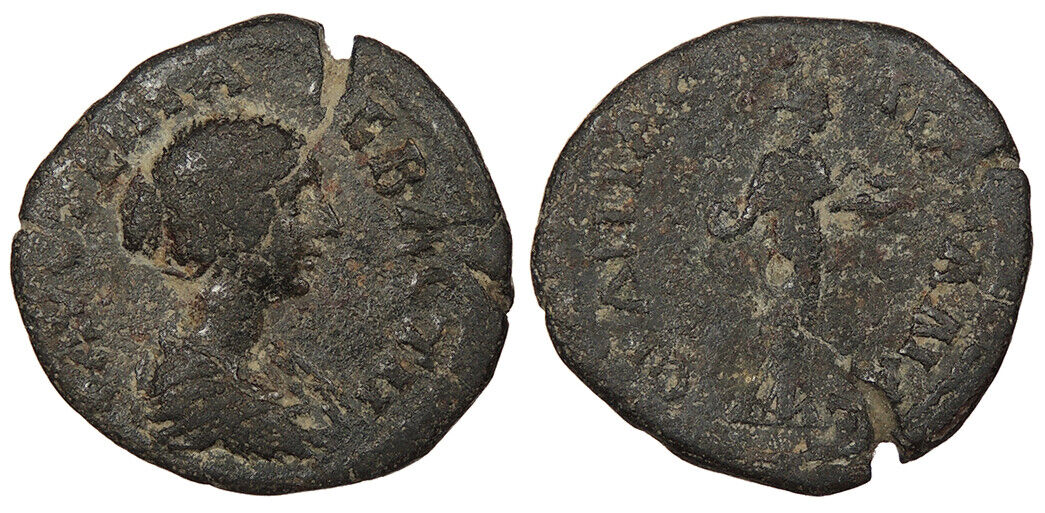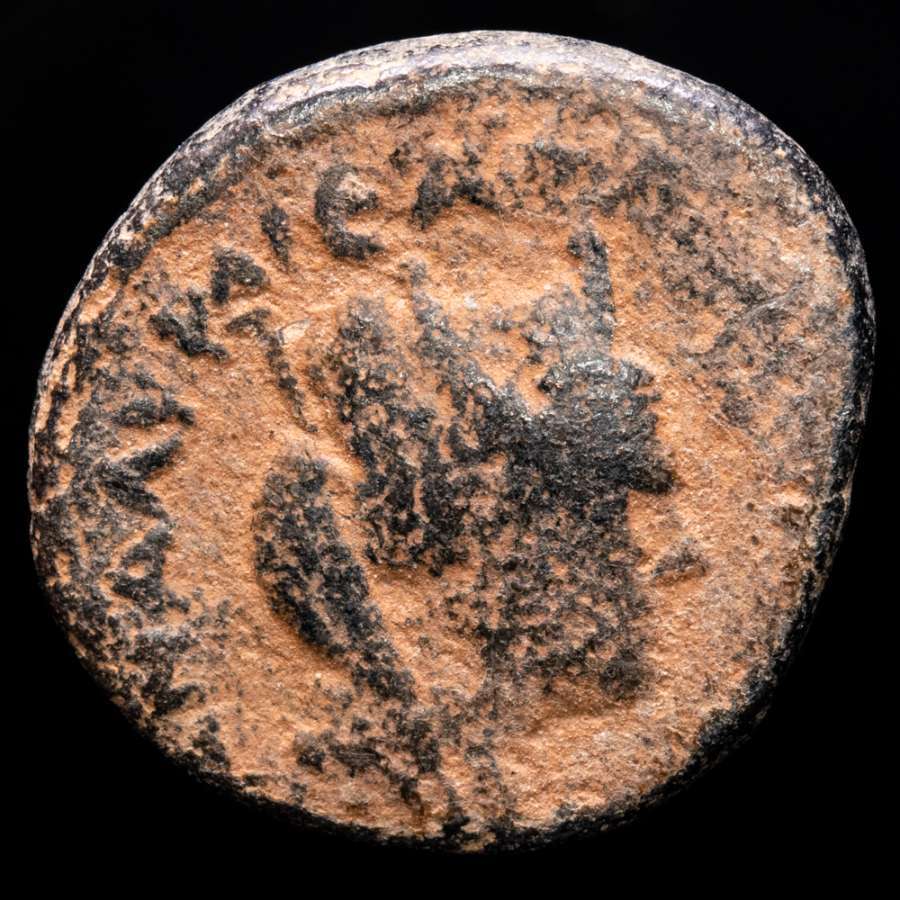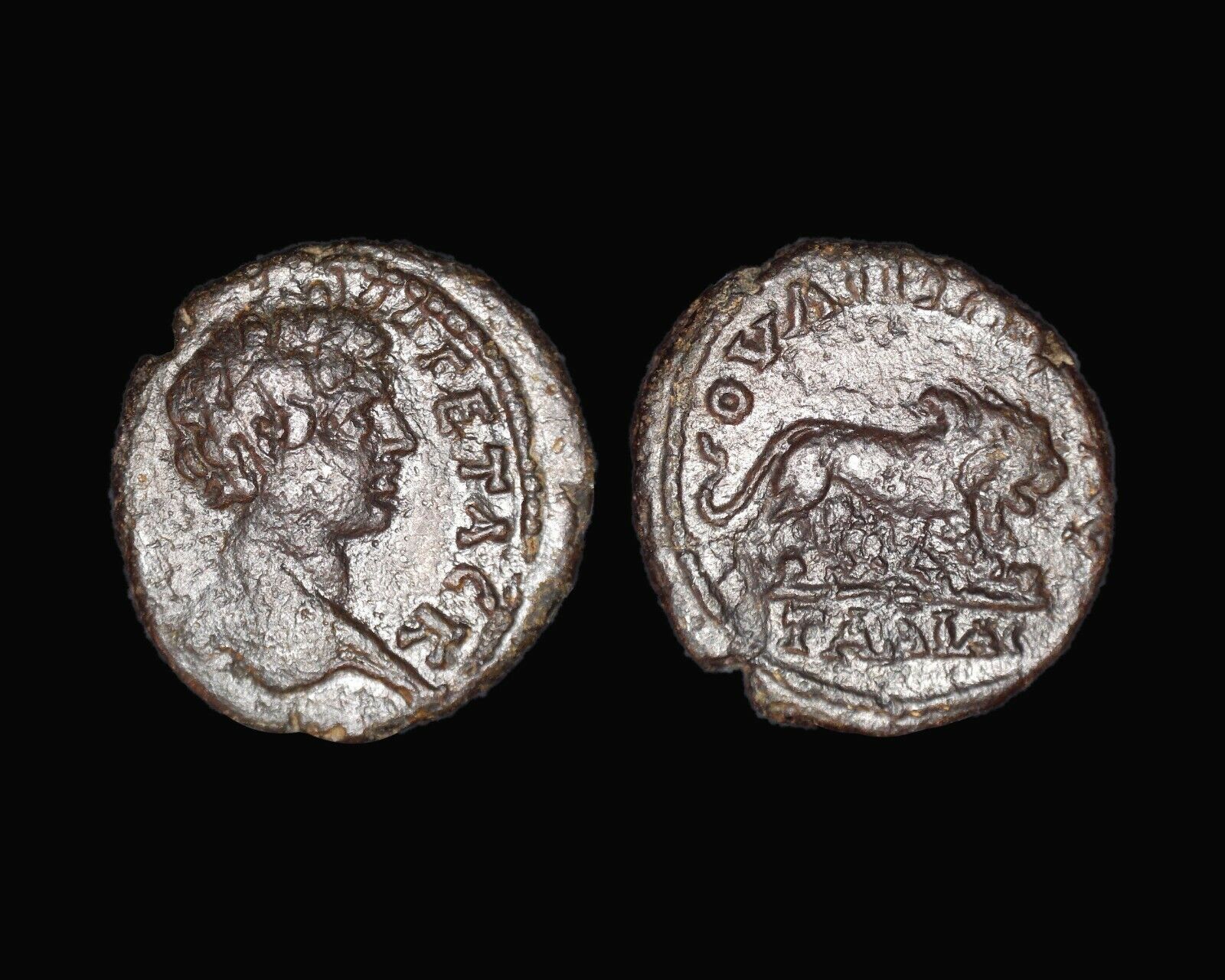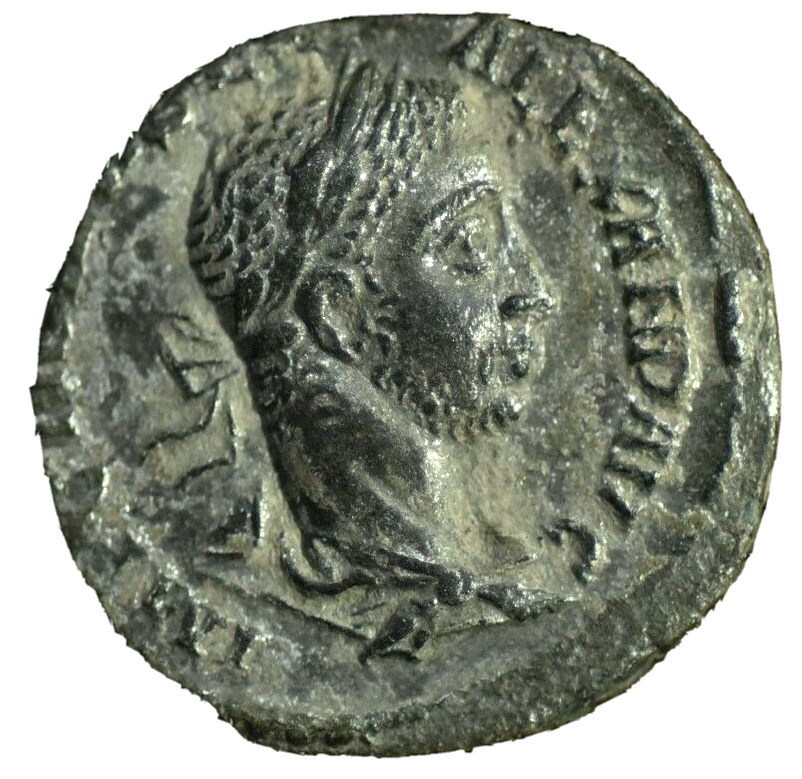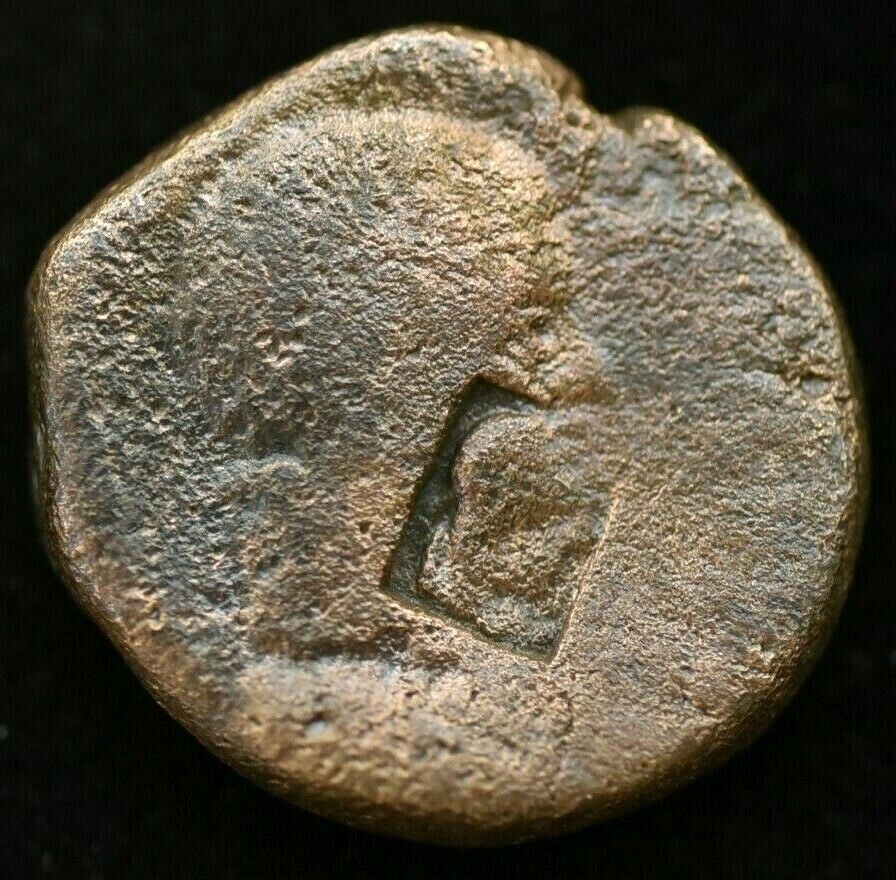-40%
Sabina wife of Hadrian Very Rare Perinthus in Thrace Ancient Roman Coin i36222
$ 52.8
- Description
- Size Guide
Description
Item:i36222
Authentic Ancient Coin of:
Sabina - Roman Empress: 117-137 A.D. - wife of Emperor Hadrian -
Bronze 21mm (3.94 grams) of Perinthus in Thrace
CABEINA CEBACTH - Draped bust of Sabina right.
ПEPINΘN, Demeter standing left holding grain ears and scepter.
You are bidding on the exact item pictured, provided with a Certificate of Authenticity and Lifetime Guarantee of Authenticity.
Vibia Sabina
(83-136/137) was a Roman Empress, wife and second cousin, once removed, to
Roman Emperor
Hadrian
. She was the daughter to
Salonina Matidia
(niece of Roman Emperor
Trajan
), and suffect consul
Lucius Vibius Sabinus
. After her father’s death in 84, Sabina along with her half-sisters lived with their grandmother, mother and were raised in the household of Trajan, his wife
Pompeia Plotina
and her stepfather.
She married Hadrian in
100
, at the Roman Empress
Pompeia Plotina
's request, for Hadrian to succeed her great uncle, in 117. Sabina's mother Matidia (Hadrian's second cousin) was also fond of Hadrian and allowed him to marry her daughter.
They had no children and had an unhappy marriage. Sabina was said to have remarked that she had taken steps to see she never had children by Hadrian because they would "harm the human race". It seems that she once
aborted
a child of theirs. Sabina was strong and independent and her beliefs in marriage didn't sit well with the Emperor. Sabina had an affair with
Suetonius
a historian (and Hadrian's secretary) in the year 119. In 128, she was awarded the title of
Augusta
. Vibia Sabina died before her husband, some time in
136
or early
137
.
//
Namesake
Vibia Aurelia Sabina
(170-died before 217), daughter and youngest child of Roman Emperor
Marcus Aurelius
and Roman Empress
Faustina the Younger
was a great, great niece to Vibia Sabina. Her name was bestowed in honor of Sabina and her father.
In
ancient Greek religion
and
myth
,
Demeter
is the goddess of the harvest, who presided over
grains
and the
fertility
of the earth. Her cult titles include Sito (
σίτος
: wheat) as the giver of food or corn/grain and
Thesmophoros
(
thesmos
: divine order, unwritten law) as a mark of the civilized existence of agricultural society.
Though Demeter is often described simply as the goddess of the harvest, she presided also over the sanctity of
marriage
, the
sacred law
, and the cycle of
life and death
. She and her daughter
Persephone
were the central figures of the
Eleusinian Mysteries
that predated the
Olympian pantheon
. In the
Linear B
Mycenean Greek
tablets of circa 1400-1200 BC found at
Pylos
, the "two mistresses and the king" may be related with Demeter, Persephone and
Poseidon
. Her
Roman
equivalent is
Ceres
.
Etymology
Didrachme
from Paros island, struck at the
Cyclades
and representing Demeter
Demeter's character as
mother-goddess
is identified in the second element of her name
meter
derived from
Proto-Indo-European
mother). In antiquity, different explanations were already proffered for the first element of her name. It is possible that
Da
(
Δᾶ
) (which became Attic
De
is the Doric form of
Ge
(
Γῆ
), "earth", the old name of the
chthonic
earth-goddess, and that Demeter is "Mother-Earth". This root also appears in the
Linear B
inscription
E-ne-si-da-o-ne
, "earth-shaker", as an aspect of the god
Poseidon
. However, the
dā
element is not so simply equated with "earth" according to
John Chadwick
.
The element
De
- may be connected with
Deo
, a surname of Demeter probably derived from the Cretan word
dea
, Ionic
zeia
meaning "barley", so that she is the Corn-Mother and the giver of food generally. Arcadian cult to Demeter links her to a male deity (Greek:
Paredros
), who accompanied the
Great Goddess
and has been interpreted as a possible substitution for
Poseidon
; Demeter may therefore be related to a
Minoan
Great Goddess
.
An alternative, Proto-Indo-European etymology comes through
Potnia
and
Despoina
; where
Des-
represents a derivative of
PIE
*dem
(house, dome), and Demeter is "mother of the house".
Agricultural deity
According to the Athenian
rhetorician
Isocrates
, Demeter's greatest gifts to humankind were agriculture, particularly of cereals, and the Mysteries which give the initiate higher hopes in this life and the afterlife. These two gifts were intimately connected in Demeter's myths and mystery cults. In Homer's
Odyssey
she is the blond-haired goddess who separates the chaff from the grain. In Hesiod, prayers to
Zeus
-Chthonios (
chthonic
Zeus) and Demeter help the crops grow full and strong. Demeter's emblem is the poppy, a bright red flower that grows among the barley.
In
Hesiod
's
Theogony
, Demeter is the daughter of
Cronus
and
Rhea
. At the marriage of
Cadmus
and
Harmonia
, Demeter lured
Iasion
away from the other revelers. They had intercourse in a
ploughed furrow
in
Crete
, and she gave birth to a son,
Ploutos
. Her daughter by Zeus was
Persephone
, Queen of the Underworld.
Festivals and cults
Main articles:
Eleusinian Mysteries
and
Thesmophoria
Demeter's two major festivals were
sacred mysteries
. Her
Thesmophoria
festival (11–13 October) was women-only. Her
Eleusinian mysteries
were open to initiates of any gender or social class. At the heart of both festivals were myths concerning Demeter as Mother and
Persephone
as her daughter.
Myths
Demeter and Persephone
Demeter drives her horse-drawn chariot containing her daughter
Persephone-Kore
at Selinunte, Sicily 6th century BC.
Demeter's virgin daughter Persephone was abducted to the underworld by
Hades
. Demeter
searched for her
ceaselessly, preoccupied with her loss and her grief. The seasons halted; living things ceased their growth, then began to die. Faced with the extinction of all life on earth,
Zeus
sent his messenger
Hermes
to the underworld to bring Persephone back.
Hades
agreed to release her, but gave her a pomegranate. When she ate the pomegranate seeds, she was bound to him for one third of the year, either the dry Mediterranean summer, when plant life is threatened by drought, or the autumn and winter. There are several variations on the basic myth. In the
Homeric hymn
to Demeter,
Hecate
assists in the search and later becomes Persephone's underworld attendant. In another, Persephone willingly and secretly eats the pomegranate seeds, thinking to deceive Hades, but is discovered and made to stay. In all versions, Persephone's time in the underworld corresponds with the unfruitful seasons of the ancient
Greek calendar
, and her return to the
upper world
with springtime. Demeter's descent to retrieve Persephone from the underworld is connected to the
Eleusinian Mysteries
.
Demeter
and her daughter
Persephone
were usually called:
The goddesses
, often distinguished as "the older" and "the younger" in
Eleusis
.
Demeters
, in
Rhodes
and
Sparta
The thesmophoroi
, "the legislators" in the
Thesmophoria
.
The Great Goddesses
, in
Arcadia
.
The mistresses
in
Arcadia
.
In
Mycenaean
Pylos
, Demeter and Persephone were probably called "queens" (wa-na-ssoi)
The myth of the capture of Persephone seems to be pre-Greek. In the Greek version Ploutos (πλούτος, wealth) represents the wealth of the corn that was stored in underground silos or ceramic jars (
pithoi
). Similar subterranean
pithoi
were used in ancient times for funerary practices is fused with Persephone, the Queen of the underworld. At the beginning of the autumn, when the corn of the old crop is laid on the fields she ascends and is reunited with her mother Demeter, for at this time the old crop and the new meet each other.
According to the personal mythology of
Robert Graves
, Persephone is not only the younger self of Demeter, she is in turn also one of three guises of the
Triple Goddess
— Kore (the youngest, the maiden, signifying green young grain), Persephone (in the middle, the nymph, signifying the ripe grain waiting to be harvested), and Hecate (the eldest of the three, the crone, the harvested grain), which to a certain extent reduces the name and role of Demeter to that of group name. Before her abduction, she is called Kore; and once taken she becomes Persephone ('she who brings destruction').
Demeter at Eleusis
Eleusinian trio
:
Persephone
,
Triptolemos
, and Demeter, on a marble
bas-relief
from
Eleusis
, 440–430 BC
Demeter's search for her daughter Persephone took her to the palace of
Celeus
, the King of
Eleusis
in
Attica
. She assumed the form of an old woman, and asked him for shelter. He took her in, to nurse
Demophon
and
Triptolemus
, his sons by
Metanira
. To reward his kindness, she planned to make Demophon immortal; she secretly anointed the boy with
ambrosia
and laid him in the flames of the hearth, to gradually burn away his mortal self. But Metanira walked in, saw her son in the fire and screamed in fright. Demeter abandoned the attempt. Instead, she taught Triptolemus the secrets of agriculture, and he in turn taught them to any who wished to learn them. Thus, humanity learned how to plant, grow and harvest grain. The myth has several versions; some are linked to figures such as
Eleusis
,
Rarus
and
Trochilus
. The Demophon element may be based on an earlier folk tale.
Demeter and Poseidon
Demeter and
Poseidon
's names appear in the earliest scratched notes in
Linear B
found at
Mycenae
and Mycenaean
Pylos
. E-ne-si-da-o-ne (earth-shaker) for Poseidon, and Si-to po-ti-ni-ja, who is probably related with Demeter.
In the myths of isolated
Arcadia
in southern Greece,
Despoina
, is daughter of Demeter and
Poseidon
Hippios
. These myths seem to be connected with the first Greek-speaking people who came from the north during the
Bronze age
. Poseidon represents the river spirit of the underworld and he appears as a horse as it often happens in northern-European folklore. He pursues the mare-Demeter and she bears one daughter who obviously originally had the form or the shape of a mare too. Demeter and Despoina were closely connected with springs and animals, related to Poseidon as a God of waters and especially with the mistress of the animals
Artemis
, the goddess of Nymphs.
Demeter as mare-goddess was pursued by Poseidon, and hid from him among the horses of King
Onkios
, but could not conceal her divinity. In the form of a stallion, Poseidon caught and covered her. Demeter was furious (
erinys
) at Poseidon's assault; in this furious form, she is known as Demeter Erinys. But she washed away her anger in the River
Ladon
, becoming
Demeter Lousia
, the "bathed Demeter".
[32]
"In her alliance with Poseidon,"
Karl Kerenyi
noted, "she was
Earth
, who bears plants and beasts, and could therefore assume the shape of an ear of
grain
or a mare." She bore a daughter
Despoina
(
Δέσποινα
: the "Mistress"), whose name should not be uttered outside the Arcadian
Mysteries
, and a horse named
Arion
, with a black mane and tail.
In
Arcadia
, Demeter's mare-form was worshiped into historical times. Her
xoanon
of Phigaleia shows how the local cult interpreted her: a Medusa type with a horse's head with snaky hair, holding a dove and a dolphin, probably representing her power over air and water.
The second mountain, Mt. Elaios, is about 30 stades from
Phigaleia
, and has a cave sacred to Demeter Melaine ["Black"]... the Phigalians say, they accounted the cave sacred to Demeter, and set up a
wooden image
in it. The image was made in the following fashion: it was seated on a rock, and was like a woman in all respects save the head. She had the head and hair of a horse, and serpents and other beasts grew out of her head. Her
chiton
reached right to her feet, and she held a dolphin in one hand, a dove in the other. Why they made the
xoanon
like this should be clear to any intelligent man who is versed in tradition. They say they named her Black because the goddess wore black clothing. However, they cannot remember who made this xoanon or how it caught fire; but when it was destroyed the Phigalians gave no new image to the goddess and largely neglected her festivals and sacrifices, until finally barrenness fell upon the land.
—
Pausanias
,
Description of Greece
8.42.1ff.
Titles and functions
Demeter's
epithets
show her many religious functions. She was the "Corn-Mother" who blesses the harvesters. Some cults interpreted her as "Mother-Earth". Demeter may be linked to goddess-cults of
Minoan
Crete
, and embody aspects of a pre-Hellenic
Great Goddess
. Her other epithets include:
Triptolemus
, Demeter and
Persephone
by the Triptolemos-painter, ca 470 BC,
Louvre
Aganippe
("the Mare who destroys mercifully", "Night-Mare")
Potnia
("mistress") in the
Homeric Hymn to Demeter
.
Hera
especially, but also
Artemis
and
Athena
, are addressed as "potnia" as well.
Despoina
("mistress of the house"), a Greek word similar to the
Mycenean
potnia
. This title was also applied to Persephone,
Aphrodite
and
Hecate
.
Thesmophoros
("giver of customs" or even "legislator"), a role that links her to the even more ancient goddess
Themis
, derived from
thesmos
, the unwritten law.
[36]
This title was connected with the
Thesmophoria
, a festival of secret women-only rituals in
Athens
connected with marriage customs.
Erinys
("implacable"), with a function similar with the function of the avenging
Dike
(Justice), goddess of moral justice based on custom rules who represents the divine retribution,
[38]
and the
Erinyes
, female ancient
chthonic
deities of vengeance and implacable agents of retribution.
Chloe
("the green shoot"), that invokes her powers of ever-returning fertility, as does Chthonia.
Chthonia
("in the ground"),
chthonic
Demeter in Sparta.
Anesidora
("sending up gifts from the earth") applied to Demeter in Pausanias 1.31.4, also appears inscribed on an Attic ceramic a name for
Pandora
on her jar.
Europa ("broad face or eyes") at Lebadaea of
Boeotia
. She was the nurse of
Trophonios
to whom a
chthonic
cult and
oracle
was dedicated.
Kidaria in the mysteries of Pheneos in Arcadia where the priest put on the mask of Demeter kept in a secret place. It seems that the cult was connected with the underworld and with an agrarian magic.
Demeter might also be invoked in the guises of:
Malophoros ("apple-bearer" or "sheep-bearer", Pausanias 1.44.3)
Lusia ("bathing", Pausanias 8.25.8)
Thermasia ("warmth", Pausanias 2.34.6)
Achaea, the name by which she was worshipped at
Athens
by the Gephyraeans who had emigrated from
Boeotia
.
[45]
[46]
Poppy goddess
:
Theocritus
, wrote of an earlier role of Demeter as a poppy goddess:
For the Greeks Demeter was still a poppy goddess
Bearing sheaves and poppies in both hands.
—
Idyll
vii.157
In a clay statuette from Gazi (Heraklion Museum, Kereny 1976 fig 15), the Minoan
poppy
goddess wears the seed capsules, sources of nourishment and narcosis, in her diadem. "It seems probable that the Great
Mother Goddess
, who bore the names Rhea and Demeter, brought the poppy with her from her Cretan cult to
Eleusis
, and it is certain that in the Cretan cult sphere, opium was prepared from poppies" (Kerenyi 1976, p 24).
Cult places
Major
cults
to Demeter are known at
Eleusis
in
Attica
, Hermion (in
Crete
,
Megara
, Celeae,
Lerna
, Aegila,
Munychia
,
Corinth
,
Delos
,
Priene
,
Akragas
,
Iasos
,
Pergamon
,
Selinus
,
Tegea
,
Thoricus
, Dion (in Macedonia)
Lykosoura
,
Mesembria
,
Enna
(Sicily), and
Samothrace
.
Demeter of Mysia had a seven-day festival at Pellené in
Arcadia
. Pausanias passed the shrine to Demeter at Mysia on the road from
Mycenae
to
Argos
but all he could draw out to explain the archaic name was a myth of an eponymous
Mysius
who venerated Demeter.
Genealogy of the Olympians in Greek mythology
Genealogy
of the
Olympians
in
Greek mythology
Uranus
Gaia
Oceanus
Hyperion
Coeus
Crius
Iapetus
Mnemosyne
Cronus
Rhea
Tethys
Theia
Phoebe
Themis
Zeus
Hera
Hestia
Demeter
Hades
Poseidon
Ares
Hephaestus
Hebe
Eileithyia
Enyo
Eris
Metis
Maia
Leto
Semele
Aphrodite
Athena
Hermes
Apollo
Artemis
Dionysus
Consorts and children
Persephone
Poseidon
Despoina
Arion
Iasion
Plutus
Philomelus
Karmanor
Eubuleus
Chrysothemis
Triptolemus
Amphitheus I
Oceanus
Dmia
Portrayals
Demeter was frequently associated with images of the harvest, including flowers, fruit, and grain. She was also sometimes pictured with her daughter Persephone.
The Black Demeter, a sculpture made by
Onatas
.
Demeter is not generally portrayed with a consort: the exception is Iasion, the youth of Crete who lay with Demeter in a thrice-ploughed field, and was sacrificed afterwards – by a jealous, and envious Zeus with a thunderbolt, Olympian mythography adds, but the Cretan site of the myth is a sign that the Hellenes knew this was an act of the ancient Demeter.
Demeter is assigned the zodiac constellation Virgo the Virgin by Marcus Manilius in his 1st century Roman work Astronomicon. In art, constellation Virgo holds Spica, a sheaf of wheat in her hand and sits beside constellation Leo the Lion.
Frequently Asked Questions
How long until my order is shipped?
Depending on the volume of sales, it may take up to 5 business days for shipment of your order after the receipt of payment.
How will I know when the order was shipped?
After your order has shipped, you will be left positive feedback, and that date should be used as a basis of estimating an arrival date.
After you shipped the order, how long will the mail take?
USPS First Class mail takes about 3-5 business days to arrive in the U.S., international shipping times cannot be estimated as they vary from country to country. I am not responsible for any USPS delivery delays, especially for an international package.
What is a certificate of authenticity and what guarantees do you give that the item is authentic?
Each of the items sold here, is provided with a Certificate of Authenticity, and a Lifetime Guarantee of Authenticity, issued by a world-renowned numismatic and antique expert that has identified over 10000 ancient coins and has provided them with the same guarantee. You will be quite happy with what you get with the COA; a professional presentation of the coin, with all of the relevant information and a picture of the coin you saw in the listing.
Compared to other certification companies, the certificate of authenticity is a -50 value. So buy a coin today and own a piece of history, guaranteed.
Is there a money back guarantee?
I offer a 30 day unconditional money back guarantee. I stand behind my coins and would be willing to exchange your order for either store credit towards other coins, or refund, minus shipping expenses, within 30 days from the receipt of your order. My goal is to have the returning customers for a lifetime, and I am so sure in my coins, their authenticity, numismatic value and beauty, I can offer such a guarantee.
Is there a number I can call you with questions about my order?
You can contact me directly via ask seller a question and request my telephone number, or go to my About Me Page to get my contact information only in regards to items purchased on eBay.
When should I leave feedback?
Once you receive your order, please leave a positive. Please don't leave any negative feedbacks, as it happens many times that people rush to leave feedback before letting sufficient time for the order to arrive. Also, if you sent an email, make sure to check for my reply in your messages before claiming that you didn't receive a response. The matter of fact is that any issues can be resolved, as reputation is most important to me. My goal is to provide superior products and quality of service.



